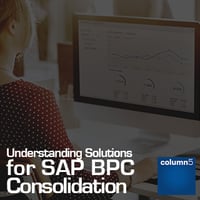Consolidations in SAP BPC are all the same out of the box, right? That may be a customer’s initial perspective when considering a BPC solution for consolidations, however, this is far from the case. Consolidation approaches are customizable to meet needs ranging from simple to very complex. The consolidation approach is a crucial decision in the BPC solution design that can be either beneficial or detrimental to your project.

What should an enterprise know before diving into this type of project? I will discuss the differing requirements of available BPC consolidation solutions and their leverageable options.
First, I will outline both simple and complex consolidation requirements.
Does your enterprise have wholly-owned subsidiaries? If so, your project may be able to leverage a simplistic approach. The primary drivers of a consolidation project’s complexity revolve around ownership in subsidiaries, and not necessarily the number of consolidating companies.
Your enterprise may have complex requirements, including:
- Several partially owned subsidiaries with minority interest
- Frequently changing ownership percentages
- Several types of equity postings dependent on company types
- Equity method investments in need of future consolidation
- Organization and ownership percentages that need to be tracked by period
BPC can support each of these scenarios, constituting a complex consolidation approach.
Simple and complex scenarios in BPC take two different implementation approaches:
- The US Elimination Business Rule Approach
- The Group Consolidations Approach
Here are some implementation impacts (from a systems perspective) of the two approaches:
The US Elimination Business Rule Approach
- Requires a ‘Finance’ model set-up rather than a ‘Consolidation’ model.
- Requires an ‘Entity’ and an ‘Interco’ type dimension set up.
- Uses a ‘lowest common parent’ elimination approach, so eliminations/consolidation execution follows the hierarchies set up in the ‘Entity’ type dimension.
- Can support several consolidation points within the ‘Entity’ type hierarchy, enabling postings at every ownership point in an enterprise.
- Consolidation points are defined by consolidation entities which hold elimination postings, providing seamless reporting.
This consolidation approach can be leveraged for most consolidation solutions, even if your enterprise has attributes of a complex consolidation.
The Group Consolidation Approach
- Requires a ‘Consolidation’ model set up with a corresponding ‘Ownership’ model referenced.
- Requires ‘Entity’ ‘Interco’ and ‘Scope’ type dimension setups.
- The ‘Ownership’ model uses the ‘Scope’ dimension to identify consolidation metrics that can shift over time (i.e. different parents, different ownership percentages, different consolidation postings, etc.).
- Several consolidation points can be defined in different ‘Scope’ dimension set-ups to facilitate shifting companies.
This consolidation approach can be leveraged for the most complex consolidation scenarios. If an enterprise requires a complex consolidation approach, we have found that Group Consolidations in BPC is the best solution on the market.
Comparison
On a functional level, here’s a comparison of the two approaches based on consolidation requirements:
| US Eliminations | Group Consolidations | |
| Can support percentage of ownership & minority interest? | Yes, requires manual journals that are manually calculated when ownership changes | Yes, can automatically assign ownership percentages and allocate applicable minority interest |
| Can apply equity method or other customized postings? | No, unless calculated outside of BPC and journaled into the system | Yes, can apply customizable consolidation rules based on partial ownership classifications |
| Can support transfers of companies within the organization? | Yes, with a difficult workaround requiring the creation of new entities for changes in ownership to preserve historical data in the historical entity hierarchy | Yes, this consolidation method is not dependent on the Entity hierarchy, just the Group assignments, so changes can be flexible |
| Can consolidate multiple points in an ownership structure? | Yes, if elimination entities are set up at all ownership points this rule quickly consolidates every point from the bottom-up | Yes, the scope will determine ownership groupings; if different ownership points need consolidation, multiple scope members need to be created, but can all run in one process |
| Monthly maintenance? | Minimal | Will have added steps to the consolidation process to ensure consolidation metrics are properly set up |
| Scaling changes maintenance? | Easy through configuration of like properties in the Entity and Intco dimensions if a new company is created or acquired | Will likely need internal expert knowledge or consultant support for significant changes |
| Execution? | Run a data manager package | Set the Consolidation Manager and run from the Web Admin |
In Summary
The Group Consolidation method is a very dynamic solution for consolidation requirements. The added layers of configuration allow extreme flexibility, but can significantly raise configuration and maintenance costs. Supported complex scenarios must be built into the technical framework, regardless of requirements, driving up implementation considerations and effort. Also, the added layers of dimensionality create more cumbersome reporting. There are companies that absolutely need these capabilities making this the best solution on the market for complex consolidation requirements, in our opinion.
In comparison, the US Elimination method is more simplistic. This is a business rule approach driven from dimension structures and property set-up. This configuration can be quickly dropped into a BPC model, and the reporting capabilities are very efficient. Also, because the set up exists in the dimensions and properties, maintenance is minimal in comparison. We have found that most companies are far better off with this approach if they don’t need the dynamics offered by Group Consolidation.
Register now for our Legal/Management Consolidations: SAP BPC Evolves with Darwin EPM webinar!
What’s right for you?
Too often enterprises have been set up with the more complex approach – this is akin to using a sledgehammer to drive in a few nails. Conversely, some enterprises have been set up with the simplistic approach and have expanded past the capacities of their system as they’ve scaled and acquired companies.
The right answer really depends on your enterprise. If the best option is not obvious consider these two criteria:
- What level of support will you have to maintain your system? This is a question of investment. The simplistic approach is minimal, while the complex approach is intensive. It’s also difficult to find or train an administrative resource in the Group Consolidation configuration
- What is your vision for the future? Does it involve acquisitions or aggressive growth? Is your enterprise subject to restructuring current or future entities? Do you intend to possess any form of partial ownership? In our experience, if these are legitimate considerations, Group Consolidations should be the path forward. If these aspects could have a significant impact, this doesn’t necessarily mean you should go with the complex route; but if you don’t, you should be well-versed on workarounds for these scenarios with the simple approach.
How to Decide
The decision is a balance between the current implementation cost and potential future requirements. Column5 is happy to assess your situation and advise you in this decision. If you feel less informed on this decision after reading this article, we can also help assess how to rectify an overly cumbersome or under-scaled consolidation system. Contact us for more information.
Related Content:
Adding Value Through the Consolidation Process - Part I
Adding Value Through the BPC Consolidation Process – Part II
Author Bio:
 Chris Montoya, a consultant at Column5, is an EPM and SAP BPC expert, with years of well-rounded SAP BPC experience and a high project success rate. Chris is also an experienced CPA with a strong technology background, who understands detailed business requirements and their intersection with EPM solutions design.
Chris Montoya, a consultant at Column5, is an EPM and SAP BPC expert, with years of well-rounded SAP BPC experience and a high project success rate. Chris is also an experienced CPA with a strong technology background, who understands detailed business requirements and their intersection with EPM solutions design.
Chris specializes in consolidation, currency translation and cash flow solutions for financial reporting and planning.











